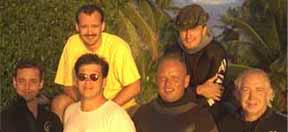
Field mixing

The Dive Team
On November 16th 1995, a team of six Cambrian Foundation divers staying at Caye Caulker, Belize, became the first people to reach the bottom of this enormous sinkhole on scuba. The depth was 408 fsw, 123 msw.
The Great Blue Hole of Belize is arguably one of the world’s leading dive sites. Situated in the centre of Lighthouse Reef, off the mainland of Belize, it attracts divers from all over the world. Jacques Cousteau took his research ship Calypso there in 1972, carefully negotiating a route through the treacherous reefs that is still used by dive boats today.
The Blue Hole gets its name from the colour of the deeper water within its depths compared with the surrounding shallows and is an enormous example of a geological phenomenon common throughout the Caribbean. Calypso’s miniature submarines discovered enormous underwater stalactites and columns beneath its overhanging walls, evidence of its karstic origin as an enormous ancient cave in the submarine limestone plateau. With supporting walls at least 1000 feet / 300 metres apart, its fragile ceiling could not support its own weight and collapsed, forming a huge undersea sinkhole. The minisubs had discovered the bottom to be a ‘lunar like plain’ of mud and limestone debris at about 400 fsw / 122 msw. One important discovery they made was some small stalactites under an overhang there, from which Cousteau inferred that the water level must at some time in the past have been at least 400 fsw / 122 msw lower than it is today.
The initial expedition in 1995 was based on Caye Caulker, a small island just south of Ambergris Caye. All helium and oxygen needed for the dive had to be shipped in, with partial-pressure field-mixing the technique used to generate the trimix 10/50 used for the bottom mix. No Haskel booster pump was available, so filling ten 80 cu. ft. cylinders with sufficient helium meant careful cascading of the helium K-bottles brought over from Belize City. Tables were cut with ProPlanner and all team members used the same gas mixes, gear configuration and decompression schedule. John Staub, our expert support diver, was on hand throughout the lengthy decompression to assist should any problems arise.
Decompression was on back-mounted air and surface-supplied oxygen, with spare aluminium 80s containing oxygen available if problems occurred with the surface supply.
The dive was planned for a rapid descent to 220 fsw / 67 msw on air, then a switch to bottom mix. At about 300 fsw / 90 msw we encountered the hydrogen sulphide layer, a murky interface made up of decomposing organic matter. 30 fsw / 9 msw deeper, we dropped into crystal-clear water with a noticeably lower temperature. As our rate of descent increased, we all turned our powerful lights downward. The white/grey bottom rushed up at us, and we arrived on a flat lunar-like silty surface studded with chunks of limestone.
I swam out from the down-line for a few minutes to see whether we were in fact on the tip of a giant debris cone similar to those seen in other cavern-collapse sinkholes, but the bottom remained flat, featureless and lifeless, a barren moonscape of thick soft silt and rocky outcrops. Directly overhead a very faint blue glow could be seen, the only sign of the outside world. We were the first humans in this isolated dark place.
All too soon our bottom time was up and it was time to go. The decompression passed without incident, we were efficiently relieved of our stage bottles by John, and we spent the last 30 minutes with the boat anchored in the colourful coral reef surrounding the hole. In the warm tropical water the time passed quickly, and soon we were back on the surface to celebrate.
- The team
- Andrew Pitkin
- Eric Tasso
- John Staub
- Andreas Matthes
- Terrence Tysall
- Hugh King
We would like to thank Frank Bounting and all his team at Belize Diving Services in Caye Caulker for their cheerful help and expertise during the preparations for this dive. Additional thanks to DIVERsions Worldwide for the accommodation and travel arrangements to and from Caye Caulker

